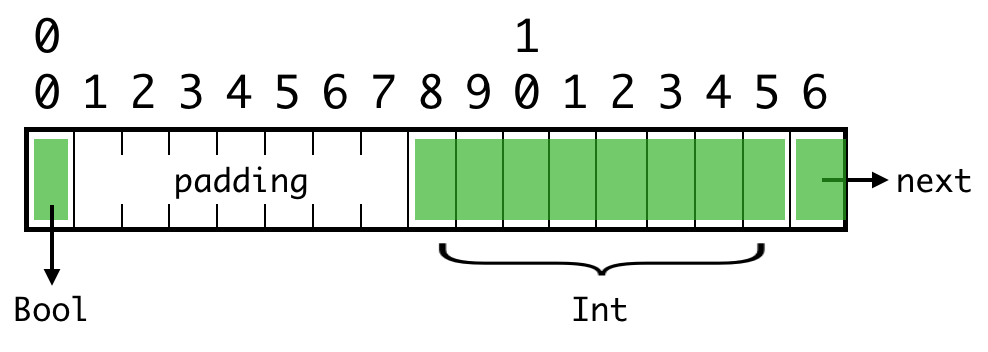【iOS内存管理优化】:数据结构在内存布局中的5个关键应用
发布时间: 2024-09-09 23:42:42 阅读量: 107 订阅数: 29 


# 1. iOS内存管理概述
在移动应用开发领域,iOS平台的性能优化一直是开发者关注的焦点。内存管理作为性能优化的核心环节之一,是确保应用程序运行稳定、快速的关键。本章将介绍iOS内存管理的基本概念和重要性,为读者铺垫接下来深入探讨的基础。
## 1.1 iOS内存管理的重要性
在iOS应用开发中,内存管理对于提高用户体验和应用稳定性至关重要。随着App功能的复杂化,高效的内存管理能够减少应用崩溃的可能性,提升程序响应速度,确保后台运行的流畅性。
## 1.2 iOS内存管理的基本模型
iOS采用引用计数机制来进行内存管理。开发者通过增加和减少对象的引用计数来控制其生命周期。当引用计数降至0时,对象占用的内存资源将被释放。这一模型虽然简单易懂,但也存在被开发者错误使用的风险,如内存泄漏和循环引用等问题。
## 1.3 本章小结
本章提供了iOS内存管理的概览,并强调了其在移动应用开发中的核心地位。接下来的章节将详细介绍内存管理的理论基础和实际应用技巧,为读者深入理解并实践高效内存管理提供必要的知识体系。
# 2. 内存管理的基础理论
内存管理是软件开发中最核心的概念之一,尤其是在资源受限的环境下,如移动端的iOS开发。在第二章中,我们将深入探讨内存管理的基础理论,为后续章节中对内存优化的讨论奠定基础。
### 2.1 内存管理的基本概念
内存管理涉及了内存的分配与释放,以及如何跟踪和管理内存的使用情况。理解这些基本概念是保证应用稳定运行的关键。
#### 2.1.1 内存的分配与释放
在iOS应用开发中,内存的分配通常是在对象被创建时由系统自动完成的。开发者需要在不再需要对象时,通过合适的释放方式归还内存给系统。这涉及到几个关键的函数:
- `alloc`:分配内存,用于创建新的对象实例。
- `init`:初始化对象,分配内存后常常需要调用初始化方法。
- `release`:减少对象的引用计数,并在计数为零时释放内存。
- `autorelease`:延迟释放对象,常用于自动释放池中。
**示例代码块:**
```objective-c
NSObject *myObject = [[NSObject alloc] init]; // 分配并初始化一个对象
[myObject release]; // 使用完毕后释放对象
```
**代码逻辑分析:**
上述代码展示了一个对象的创建和释放过程。`alloc` 方法分配内存,而 `init` 方法确保对象被正确初始化。当对象不再被需要时,`release` 方法将减少对象的引用计数。当引用计数降至零时,对象占用的内存会被自动释放。
#### 2.1.2 引用计数与内存持有者
引用计数是内存管理中的一个核心机制,用于追踪对象有多少个引用指向它。当引用计数为零时,对象将被释放。理解引用计数的概念对于避免内存泄漏至关重要。
**表格: 引用计数变化示例**
| 操作 | 引用计数变化 | 结果 |
| --- | --- | --- |
| alloc | +1 | 引用计数从0变到1 |
| retain | +1 | 引用计数增加1 |
| release | -1 | 引用计数减少1 |
| autoreleased | +1(延迟释放) | 引用计数暂时增加,之后会自动调用release |
**示例代码块:**
```objective-c
NSObject *object = [[NSObject alloc] init]; // 引用计数为1
NSObject *aliasObject = object; // 引用计数变为2
[object release]; // 引用计数减少1
[aliasObject release]; // 引用计数减少1,此时对象被释放
```
**代码逻辑分析:**
在示例中,通过`alloc`创建对象时,对象的引用计数为1。将对象赋值给新的变量`aliasObject`时,引用计数增加到2。当调用`release`时,引用计数减少1,变为1。再释放`aliasObject`时,引用计数变为0,对象随即被销毁。
### 2.2 内存泄漏与循环引用
内存泄漏和循环引用是iOS开发中常见的问题,它们会导致应用的内存使用不断增加,最终可能导致应用崩溃。
#### 2.2.1 内存泄漏的识别与危害
内存泄漏是指应用程序无法释放已经不再使用的内存,这将导致可用内存逐渐减少,应用性能下降。
**示例代码块:**
```objective-c
for (int i = 0; i < 100; i++) {
NSObject *leakObject = [[NSObject alloc] init];
// 假设在循环中应该有一次release,但因为错误而遗漏了
}
```
**代码逻辑分析:**
上述代码中,由于忘记在循环体内部释放对象,每次循环都会创建一个新的对象,而没有任何释放动作,从而导致内存泄漏。泄漏的内存会随着时间累积,导致可用内存不断减少。
#### 2.2.2 循环引用的检测与解决
循环引用是指两个或多个对象相互引用,但又没有适当的释放机制,造成它们都无法释放。
**示例代码块:**
```objective-c
@interface MyObject : NSObject
@property (nonatomic, strong) id delegate; // strong意味着持有
@end
@implementation MyObject
@end
MyObject *obj1 = [[MyObject alloc] init];
MyObject *obj2 = [[MyObject alloc] init];
obj1.delegate = obj2;
obj2.delegate = obj1;
// 这两个对象都无法释放,因为它们相互持有
```
**代码逻辑分析:**
上述代码中,`MyObject`的实例`obj1`和`obj2`互相成为对方的代理(delegate),形成了一个循环引用。即使调用了`release`,这两个对象的引用计数都不会变为0,因此它们不会被释放,从而导致内存泄漏。
在实际开发中,可以使用Xcode的Instruments工具来检测循环引用。解决方法通常是使用弱引用(weak reference)来打破循环引用。
以上内容涵盖了内存管理基础理论的关键方面。在下一章,我们将探索数据结构对内存布局的影响,进而进一步理解如何有效地优化内存使用。
# 3. 数据结构对内存布局的影响
## 3.1 数据结构的内存布局基础
### 3.1.1 结构体与类的内存占用
在iOS开发中,结构体(struct)和类(class)是常用的数据类型,它们在内存中的表示方式有所不同。结构体是值类型,通常分配在栈上;而类是引用类型,其对象存储在堆上。结构体中的所有成员都存储在连续的内存块中,每个成员占用的内存大小等于其自身大小。类的对象则包括了指向其类对象的指针、引用计数以及其他实例变量的内存。
内存占用不仅包括了成员变量的大小,还有可能因为内存对齐而产生额外的空间。对齐主要是为了满足硬件平台的内存访问效率,不同平台的对齐方式可能会有所不同。例如,在iOS中,使用 ARM 架构的设备通常要求成员变量按 4 字节或其倍数进行对齐。
### 3.1.2 数据对齐与内存布局优化
数据对齐有助于提升性能,但有时候也会导致内存的浪费。一个典型的优化手段是利用结构体的紧凑排列,即手动调整结构体成员的声明顺序,来减少内存的空隙。在Swift中,可以使用`@_alignas`属性来指定对齐要求。
在Objective-C中,使用`#pragma pack`可以实现手动对齐,而在Swift中,可以通过结构体包装小的成员变量来优化内存布局。举个例子,如果一个结构体只需要8字节,
0
0





